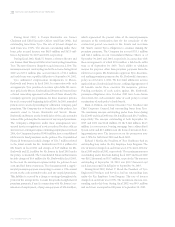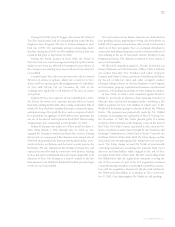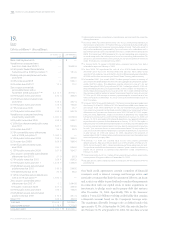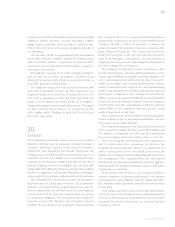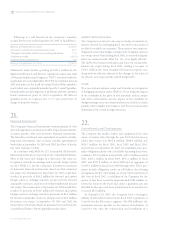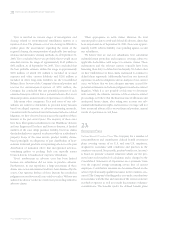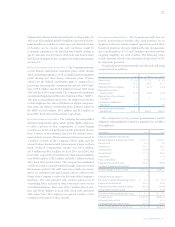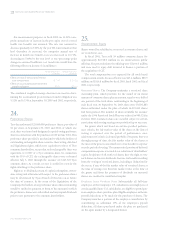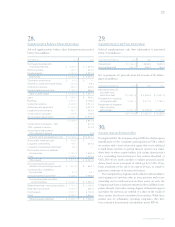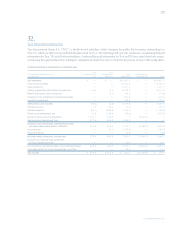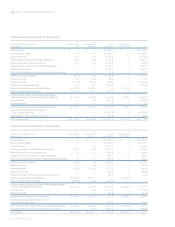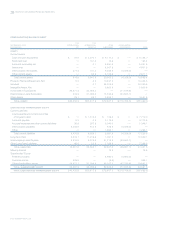ADT 2003 Annual Report Download - page 114
Download and view the complete annual report
Please find page 114 of the 2003 ADT annual report below. You can navigate through the pages in the report by either clicking on the pages listed below, or by using the keyword search tool below to find specific information within the annual report.
112
For measurement purposes, in fiscal 2003, an 11.55% com-
posite annual rate of increase in the per capita cost of covered
health care benefits was assumed. The rate was assumed to
decrease gradually to 5.00% by the year 2011 and remain at that
level thereafter. At year-end, the composite annual rate of
increase in health care benefit costs was increased to 12.71%,
decreasing to 5.00% by the year 2013. A one-percentage-point
change in assumed healthcare cost trend rates would have the
following effects on income ($ in millions):
1-PERCENTAGE-POINT 1-PERCENTAGE-POINT
INCREASE DECREASE
Effect on total of service and interest
cost components $««1.4 $««(1.2)
Effect on accumulated postretirement
benefit obligation 25.2 (22.1)
The combined weighted-average discount rate used in deter-
mining the accumulated postretirement benefit obligation was
5.52% and 6.75% at September 30, 2003 and 2002, respectively.
24.
Preference Shares
Tyco has authorized 125,000,000 preference shares, par value of
$1 per share, at September 30, 2003 and 2002, of which one
such share was issued and designated a special voting preference
share in connection with the purchase of CIT in June 2001. This
preference share provided a mechanism by which the holders of
outstanding exchangeable shares exercise their voting, dividend
and liquidation rights, which were equivalent to those of Tyco
common shareholders, except that each exchangeable share was
equivalent to 0.6907 of a Tyco common share. In connection
with the IPO of CIT, the exchangeable shares were redeemed
effective July 5, 2002 through the issuance of 3,243,322 Tyco
common shares. As a result, no one is entitled to exercise the
rights attaching to the preference share.
Rights as to dividends, return of capital, redemption, conver-
sion, voting and otherwise with respect to the preference shares
may be determined by Tyco’s Board of Directors on or before
the time of issuance. In the event of the liquidation of the
Company, the holders of any preference shares then outstanding
would be entitled to payment to them of the amount for which
the preference shares were subscribed and any unpaid dividends
prior to any payment to the common shareholders.
25.
Shareholders’ Equity
Shares owned by subsidiaries are treated as treasury shares and
are recorded at cost.
In fiscal 2001, Tyco sold 39 million common shares for
approximately $2,198.0 million in an underwritten public
offering. Net proceeds from the offering were $2,196.6 million
and were used to repay debt incurred to finance a portion of
the acquisition of CIT.
The total compensation cost expensed for all stock-based
compensation awards discussed below was $43.4 million, $89.9
million and $116.8 million for fiscal 2003, fiscal 2002 and fiscal
2001, respectively.
Restricted Shares The Company maintains a restricted share
ownership plan, which provides for the award of an initial
amount of common shares plus an amount equal to one-half of
one percent of the total shares outstanding at the beginning of
each fiscal year. At September 30, 2003, there were 59,831,883
shares authorized under the plan, of which 16,223,413 shares
had been granted. The number of shares available for issuance
under the 1994 Restricted Stock Plan was reduced to 999,524 in
October 2002. Common shares are awarded subject to certain
restrictions with vesting varying over periods of up to ten years.
For grants which vest based on certain specified perform-
ance criteria, the fair market value of the shares at the date of
vesting is expensed over the period of performance, once
achievement of criteria is deemed probable. For grants that vest
through passage of time, the fair market value of the shares at
the time of the grant is amortized (net of tax benefit) to expense
over the period of vesting. The unamortized portion of deferred
compensation expense is recorded as a reduction of shareholders’
equity. Recipients of all restricted shares have the right to vote
such shares and receive dividends. Income tax benefits resulting
from the vesting of restricted shares, including a deduction for
the excess, if any, of the fair market value of restricted shares at
the time of vesting over their fair market value at the time of
the grants and from the payment of dividends on unvested
shares, are credited to contributed surplus.
Employee Stock Purchase Plans Substantially all full-time
employees of the Company’s U.S. subsidiaries and employees of
certain qualified non-U.S. subsidiaries are eligible to participate
in an employee share purchase plan. Eligible employees authorize
payroll deductions to be made for the purchase of shares. The
Company matches a portion of the employee contribution by
contributing an additional 15% of the employee’s payroll
deduction. All shares purchased under the plan are purchased
on the open market by a designated broker.
TYCO INTERNATIONAL LTD.
Notes to Consolidated Financial Statements


